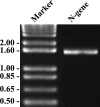Seroprevalence of turkey coronavirus in North American turkeys determined by a newly developed enzyme-linked immunosorbent assay based on recombinant antigen
- PMID: 18971306
- PMCID: PMC2593163
- DOI: 10.1128/CVI.00319-08
Seroprevalence of turkey coronavirus in North American turkeys determined by a newly developed enzyme-linked immunosorbent assay based on recombinant antigen
Abstract
Turkey coronavirus (TCoV) causes diarrhea in young turkey poults, but little is known about its prevalence in the field. To address this, the complete nucleocapsid gene was cloned and expressed in Escherichia coli. Expressed nucleocapsid gene produced two distinct proteins (52 and 43 kDa); their specificity was confirmed by Western blotting using two different monoclonal antibodies. Recombinant N protein was purified and used as an antigen to develop an enzyme-linked immunosorbent assay (ELISA) for the serological detection of TCoV that was then validated using experimentally derived turkey serum. The N-based ELISA showed (97%) sensitivity and (93%) specificity for TCoV, which was significantly higher than an infectious bronchitis coronavirus-based commercial test for TCoV. To assess the utility of this recombinant ELISA, 360 serum samples from turkey farms in Ontario, Canada, and 81 serum samples from farms in Arkansas were tested for TCoV-specific antibodies. A high seroprevalence of TCoV was found in turkeys from the Ontario farms with 73.9% of breeders and 60.0% of meat turkeys testing seropositive using the N-based ELISA. Similarly, a high field prevalence was found in the turkeys from Arkansas, for which 64.2% of the serum samples tested seropositive.
Figures





Similar articles
-
Recombinant nucleocapsid protein-based enzyme-linked immunosorbent assay for detection of antibody to turkey coronavirus.J Virol Methods. 2015 Jun 1;217:36-41. doi: 10.1016/j.jviromet.2015.02.024. Epub 2015 Mar 5. J Virol Methods. 2015. PMID: 25745958 Free PMC article.
-
Use of recombinant S1 spike polypeptide to develop a TCoV-specific antibody ELISA.Vet Microbiol. 2009 Sep 18;138(3-4):281-8. doi: 10.1016/j.vetmic.2009.04.010. Epub 2009 Apr 10. Vet Microbiol. 2009. PMID: 19414227 Free PMC article.
-
Detection of antibody to turkey coronavirus by antibody-capture enzyme-linked immunosorbent assay utilizing infectious bronchitis virus antigen.Avian Dis. 2000 Jul-Sep;44(3):498-506. Avian Dis. 2000. PMID: 11006996
-
Hemorrhagic enteritis of turkeys.Vet Immunol Immunopathol. 1991 Nov;30(1):67-71. doi: 10.1016/0165-2427(91)90009-2. Vet Immunol Immunopathol. 1991. PMID: 1664163 Review.
-
Immunopathogenesis of haemorrhagic enteritis virus (HEV) in turkeys.Dev Comp Immunol. 2000 Mar-Apr;24(2-3):237-46. doi: 10.1016/s0145-305x(99)00075-0. Dev Comp Immunol. 2000. PMID: 10717290 Review.
Cited by
-
Enteric viruses in turkey enteritis.Virusdisease. 2014;25(2):173-85. doi: 10.1007/s13337-014-0198-8. Epub 2014 Feb 19. Virusdisease. 2014. PMID: 25674583 Free PMC article.
-
Recombinant nucleocapsid protein-based enzyme-linked immunosorbent assay for detection of antibody to turkey coronavirus.J Virol Methods. 2015 Jun 1;217:36-41. doi: 10.1016/j.jviromet.2015.02.024. Epub 2015 Mar 5. J Virol Methods. 2015. PMID: 25745958 Free PMC article.
-
The efficacy of the prime-boost regimen for heterologous infectious bronchitis vaccines mandates the administration of homologous vaccines.Virusdisease. 2022 Sep;33(3):291-302. doi: 10.1007/s13337-022-00780-0. Epub 2022 Aug 29. Virusdisease. 2022. PMID: 36059721 Free PMC article.
-
Use of recombinant S1 spike polypeptide to develop a TCoV-specific antibody ELISA.Vet Microbiol. 2009 Sep 18;138(3-4):281-8. doi: 10.1016/j.vetmic.2009.04.010. Epub 2009 Apr 10. Vet Microbiol. 2009. PMID: 19414227 Free PMC article.
-
Identification and characterization of a neutralizing-epitope-containing spike protein fragment in turkey coronavirus.Arch Virol. 2011 Sep;156(9):1525-35. doi: 10.1007/s00705-011-1020-1. Epub 2011 May 19. Arch Virol. 2011. PMID: 21594597 Free PMC article.
References
-
- Ahmed, S., M. Bassiri, A. K. Banerjee, and T. Yilma. 1993. Immunological characterization of VSV nucleocapsid protein expressed by baculovirus in Spodoptera exigua larva: use in differential diagnosis between vaccinated and infected animals. Virology 192:207-216. - PubMed
-
- Ali, A., and D. L. Reynolds. 1998. The in vitro propagation of stunting syndrome agent. Avian Dis. 42:657-666. - PubMed
-
- Breslin, J. J., L. G. Smith, and J. S. Guy. 2001. Baculovirus expression of turkey coronavirus nucleocapsid protein. Avian Dis. 45:136-143. - PubMed
-
- Cavanagh, D. 2001. The role of coronaviruses in enteric diseases of turkeys, p. 31. Proceedings of the 24th Technical Turkey Conference. http://www.poultry-health.com/fora/turkhelth/turtec24/cavanagh.htm.
Publication types
MeSH terms
Substances
LinkOut - more resources
Full Text Sources

